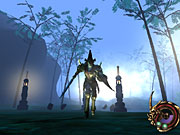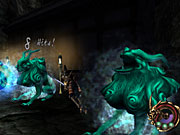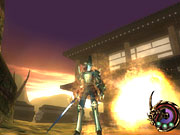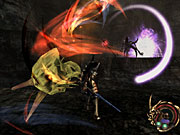Otogi: The Myth of Demons Preview
We take an exclusive look at the localized version of From Software's mythical Xbox action game.
If you've ever wondered what it would be like to be an undead warrior pitted against an army of demons, From Software and Sega have a game for you. Otogi: Myth of Demons, which was released earlier this year in Japan, puts you in the role of Raiko, a warrior hauled back from the afterlife to deal with a demonic army that seems pretty set on bringing about doomsday. Given the rather traumatic nature of coming back from the dead on such short notice, Raiko isn't quite at the peak of his ass-kicking skills. As you progress through the game, Raiko will gain experience and grow more powerful with every demon he returns to the afterlife. We recently took a localized version of the game for a spin to see how it's coming together for its US release.

Otogi features a basic mission-based structure that, along with its gameplay, bears more than a passing resemblance to Sega's own Shinobi for the PlayStation 2. When you first start the game, you'll spend a bit of time being briefed on its story and pertinent plot points. Following the intro, you'll start out in a tutorial level that will fill you in on the basics of being a newly revived undead warrior. Once you get through the tutorial, you'll come to a tally screen showing off your performance in the level and then move to a menu screen that will let you perform some general maintenance on Raiko. As you go through the game, you'll gain experience that will go toward increasing Raiko's level, thus increasing his overall stats. You'll also earn cash, since, as we all know, the corpses of slain demons are basically magical ATMs. You'll be able to spend your cash in the game's shop, which will let you buy weapons, magic, and accessories. In addition, you'll be able to restore your weapon's vitality, which runs down as you slay the demon hordes. Once you're done blowing your cash, you can pop into the equip screen and try on your goods. You'll be able to equip a weapon, a magic type, and an accessory, all of which have their own pros and cons, depending on your preferred play style.
Once you sort out your gear, you can hop into the game and start "cleansing," which is undead-warrior speak for "killing all the demons." The game's accessible control scheme makes "cleansing" easy and fun. You'll move Raiko around with the left analog stick. The left trigger will lock you on to an enemy, and the right trigger will let you dash in the air. The A button will let you perform a single or double jump on the ground or in the air. The rest of the Xbox face buttons will be used for your attacks. The B button is a basic "small" attack, the Y button is a more-powerful "great" attack, and the X button will let you use your magic. While the trio of buttons may not seem like much, you'll be able to perform some impressive combos with them by varying their order. In addition, your magic will come in four different varieties, each with three power levels.
While Raiko may sound quite powerful, he does come with a bit of baggage. Sadly, the old boy is dependent on magic energy, which runs down over the course of a level. The mechanic works a lot like the sword in Shinobi, which required you to keep it well fed. In Otogi, your life is tied closely to your magic gauge--if it empties completely, your health starts to drain quickly. As a result, you'll find yourself trying to plow through enemies, who give up health and magic power-ups, as well as the aforementioned cash, as quickly and efficiently as possible.
Your tasks in most of the stages will involve killing off all the undead on the level and facing a boss-type character every so often. While it may sound repetitive, there's quite a bit of variety in the game, thanks to the inclusion of some puzzles and some slick level design. Later levels will even throw some new twists into the mix--such as enemies and hazards that appear only when the moon is visible--that will force you to pay attention to your surroundings. In some ways, the game reminds us of Smilebit's Gunvalkyrie, as it's possible to go for long stretches and never touch the ground if you time your dashes properly.

The graphics in the game are a stylish mix of cool design and Xbox eye candy. Raiko's detailed character model looks like a cross between Yoshimitsu from Tekken and Nightmare from Soul Calibur. While that may sound a bit awkward, it actually works well and fits the game's eerie tone. The other creatures you'll encounter in the game aren't quite as sharp but do sport a respectable amount of detail. The environments are impressive, thanks to their sheer size, unique design, and numerous destructible objects. Given the game's mythological slant, plan on seeing a wide assortment of special effects used for the magic attacks and other phenomenon that will crop up in the game. Not only do the various lighting, pixel shader, filter, and particle effects look cool, but they also perfectly set the atmosphere in the game. The most impressive thing about Otogi's unique graphical style is that it offers a very cohesive look that isn't too showy. Whereas as some Xbox games cram in every graphical bell and whistle possible, resulting in some painfully overdone graphics, Otogi's visuals all work to create an ethereal world that looks great. Little touches such as a golden glow from the sun in outdoor levels and subtler effects when you're indoors are both impressive and artistic. The game's visuals have been tweaked a bit for its US release. Some of the additions include the wake kicked up when Raiko dashes, some flame effects, and the clouds that are kicked up when you destroy buildings. All the effects have been toned down a bit so as not to obscure your view as much as they did in the Japanese game. The only real weak points in the visuals are an occasionally troublesome camera and a modest frame rate that hitches on occasion.

The audio in Otogi consists of a strong mix of music, sound effects, and voice acting that plays off the game's creepy settings nicely. The soundtrack is a very unique mix of tunes that are heavily influenced by traditional Japanese music. While it may not be everyone's cup of tea--there are a few tracks in the game that wouldn't be out of place on a Yoko Ono album--the tunes are a perfect complement to the action and story. The sound effects are very satisfying, though the voice acting in the game is a bit sketchier. While there's nothing really broken about it, Otogi's English voice acting lacks the personality to match its stylish visuals. Fortunately, you'll be able to swap in Japanese voice work if you want the full-on experience.
From what we've played so far, Otogi is looking very good. The game's mix of action and RPG elements works well, and the story is interesting. The graphics and audio combine to create a unique and stylish presentation that complements the gameplay. Anyone craving a tight action game or curious about fighting demonic armies should keep an eye out for Otogi: Myth of Demons when it ships next month.
Got a news tip or want to contact us directly? Email news@gamespot.com

Join the conversation